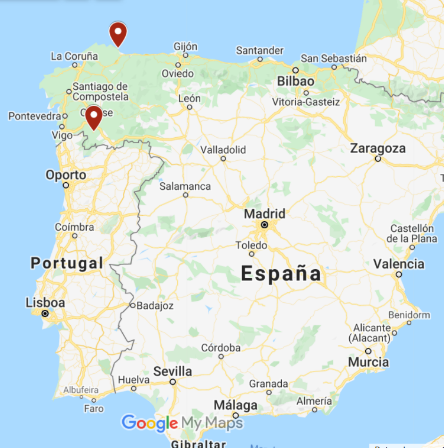Powerful women-led organisations in shrinking regions
by Leticia Santaballa Santos
During the pandemic, fieldwork became a challenge. Nevertheless, the University of A Coruna team was able to start the Welcoming Spaces research on two of the selected case studies, thanks to the low prevalence of active COVID-19 cases over a period of several weeks in the autumn of 2020.

Map shows the location of the two municipalities, Celanova (south) and Burela (north). Source: Google Maps.
Celanova is a Spanish municipality located inland in the Galician region, in province of Ourense. Burela, in turn, is a coastal village in the far north of the same region, in the province of Lugo. We could be forgiven for thinking that the two municipalities would have little in common; nevertheless, once out on the field, we were able to identify a shared singularity: powerful women-led cultural organisations with scope that extends far beyond their geographical boundaries. Indeed, our conversations with various agents in situ revealed a clear trans-local relevance.
Both locations are characterised by large migrant communities, albeit with widely-differing migration projects underlying people’s movements. In Celanova, most of the “new” neighbours formerly lived in Venezuela. They already held Spanish citizenship, as many of them are returned Galician descendants, although some had never previously visited their ancestors’ country of origin, whilst others had travelled there regularly to spend their summer holidays. Nevertheless, influxes and effluxes to and from Latin American countries had existed since the Galician diaspora of the early 20th century. In recent years, a steadily rising one-way trend, consisting mainly of migrants fleeing Venezuela, has rejuvenated an otherwise rapidly ageing population, the result of constant outward migration and falling birth rates.
Forty-five years ago, Burela, once a small village, began to receive people of Cape Verdean/Portuguese nationality, mainly for economic reasons related to the building and fishing industries. As the structural situation was prosperous at the time, people from other villages/regions/countries arrived and settled, and many were able to regroup their families. In a few decades Burela became a fully serviced municipality with a population of over 10,000 and more than 40 nationalities. However, the extent to which they integrated is an issue for study in future analyses.
The Batuko Tabanka Association had a long-standing trajectory as a cultural organisation, although it was further strengthened under female leadership in the wake of Bogavante, a social project that ran from 1998 to 2020. In turn, this led to the creation of a Batuque dance and music group whose origins lie in the dreadful times of slavery. You can listen to one of their songs here: https://www.youtube.com/watch?v=efmP5hEwWBA

Mural dedicated to the Batuko Tabanka Association on a street in Burela. Source: Servizo de Audiovisuais da Diputación de Lugo, 2019.
In addition, the Cantaclaro Association started life as a cultural organisation that aimed to conserve and promote Venezuelan culture and values, as well as creating intercultural shared spaces within Galicia, providing interested participants of all ages with the opportunity to take part in traditional music courses (learning to play the cuatro stringinstrument, for example), dancing, workshops and many other activities.

Some of the activities carried out by Asociación Cantaclaro (Celanova). Source: La Región newspaper, 2020.
When it comes to migration discourses, memory tends to be short-lived. Due to its relevance, we must never forget Galicia’s long-standing tradition of emigration that is still alive today. Indeed, the popular saying “there’s a Galician on the moon” is indicative of the scope and extent of a phenomenon that extended as far afield as Switzerland, Germany, Bolivia, Brazil, Argentina, Venezuela, Uruguay, Cuba, Belgium, Canada and even Australia – just some of the countries where it is possible to find Galician cultural organisations that remain active even today.

Example of a Galician cultural organization in Switzerland. Source: Expaña Exterior Journal, 2019.
So, what do they have in common? Organisations in shrinking areas could be seen as the visible face of a migrant-based community, but their reach is wide and deeply rooted in the location. It goes far beyond the workshops, activities and concerts, and in many cases provides a supportive hand to hold along the way, when carrying out the basic procedures, or providing a sense of direction in a new environment, which comes from experienced voices in both realities. During the interviews, many of the returned Galician voices reminded us of the importance of the cultural organisations abroad, whose impact extends far beyond the actual migrant community, proving essential for development and schools houses, business and medical centres, all crucial for cultural reproduction, as well as enhancing development and social wellbeing for both reception and sending countries.
We began to perceive that their impact is far from trivial. In this sense, research into Welcoming Spaces should thoroughly and ethically address the contributions of cultural organisations. How do other agents interact with migrant community organisations in shrinking regions? How are communities organised and what are their demands? Are they really considered as key agents for development? It may well be that we will discover valuable and underestimated reception know-how.

